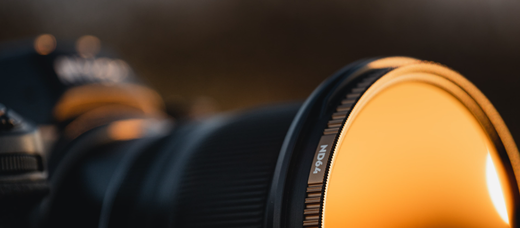Hobbyists of photography at times tend to not think further than the lens of their camera, it’s hardly ever a concern to add extra gear or even filters to inconvenience those spur-of-the-moment shots. We know that also comes with many misses and subsequent retouches, so if you want to turn otherwise unusable photos into masterful artwork then filters have the potential to do just that.
If you’ve made the leap to explore filter use on your camera and need a little help figuring out what’s the best time of the day to use them, you’ve come to the right place. As the most popular filter in our PolarPro filter collection, the neutral density (ND) filter is also usually the first purchase when experimenting with your craft especially to control excess light on a bright sunny day or catch movement in the dim of the evening.
There is an exhaustive selection of neutral density filters to choose from as well, and this can be pretty intimidating for a beginner photographer. A great base to work with is the collection from our QuartzLine filters that has the ND8, ND16, ND64, ND1000, and ND100k, which can take on several types of lighting conditions throughout the day and late evening.
First, let’s discuss the uses and what’s the best time of day to use ND filters and specifically which ones to use for those moments.
Why Use ND Filters?
ND filters are particularly useful for maintaining the color effect of images while controlling the exposure in bright light conditions. A filter prevents excess light from reaching the camera sensor so photographers can shoot in a wider aperture for longer periods. So with the implementation of filters, you can set the aperture to wide-open for a shallow depth of field to obtain sharper images. While images in focus become sharper, backgrounds become blurred.
Neutral density filters are also commonly used to blur movement, especially images in constant motion such as waterways, rain, waterfalls, or people on a busy street, otherwise, your camera would be unable to adjust to an aperture wide enough to get the same effect without overexposing the photo.
So if you want to capture an image exactly the way you see it without overexposing the shot while seizing movement in the surrounding, then an ND filter is the way to go.
How Are They Used?
Filters are placed in front of the camera lens and are available in different intensities, which are designated by a number of stop values. Users can switch between the stop values to arrive at the desired exposure or optical density strength depending on how much light is entering the lens. Unlike the variable neutral density (VND) filter that dials between stop values with a single filter, the ND has a filter for each stop value, so you’d have to physically swap out the different filters. Many creators prefer ND filters for this reason as manually swapping filters offer more precision control during shooting. It comes down to a matter of preference.
Best ND Filters For The Morning
The neutral density filters that are best for the morning time, after sunrise, and somewhere around midday when the sun is at its brightest, are the darker tinted filters of higher densities. From our QuartzLine selection, the 6-stop ND64 and 10- stop ND1000 allow slower shutter speed and very wide aperture shooting under bright sunlight. This is ideal for smoothing waterfalls and blurring clouds over several minutes in intense light by reducing the exposure while preserving the contrast and dynamic range of a shot. A higher 15-stop ND100k filter in particular is perfect for managing extremely bright light and can even capture images with the sun directly in the frame.
Great morning shots are also achieved with graduated neutral density (GND) filters. These transition from dark to clear in order to help darken very bright skies and keep the focus and clarity of the ground. They balance out exposure during bright morning light when contrasts are distinct between the lights and darks.
Best ND Filters During The Golden Hour
The golden hour is during that first phase of sunlight at the crack of dawn and likewise, is the last hour of the day at sundown when the sun is near the horizon. The filters that capture this phenomenon best while ensuring color reproduction is fully neutral are in the mid to lower density range. Using the 6-stop ND64 or 4-stop ND16 filter are both great choices to maintain the vibrancy of objects during this time, which are usually much warmer and more colorful compared to when the sun rises higher in the sky (later morning), as the light tends to be less colorful and quite flat. The 4-stop reduction of the ND16 allows controlled shutter speed that will ensure your image remains sharp as light during this time of day is subdued and can create a slight haze on objects.
Graduated filters too, are a good option to really make your photography pop during the golden hour. A soft ND16 GR filter will balance the exposure of the sky and ground just enough to capture the sunset or sunrise in its truest tones.
Best ND Filters For Nighttime
Nighttime shots that require neutral density filters are those wanting to catch a streaking light of some kind, like fireworks or descending taillights. They are also necessary to blur water in motion under dim light conditions or even remove obstacles or blur people that happen to get in your shot.
So the low-light environment of night photography will require slower shutter speed and longer exposure than available light (or darkness) will permit with a small aperture for max depth of field. This is why a 3-stop reduction, ND8 filter is the best to enhance and sharpen light activity in the dark while giving your image a smooth effect.
Otherwise, ND filters aren’t really recommended for night shooting unless paired with a polarizer. The 3-stop ND8/PL QuartzLine filter would be a great suggestion to explore your nighttime photography.
Precision Filter Control With The Summit Landscape System
So neutral density filters as well as graduated neutral density filters are quite resourceful for photography all throughout the day. There are all-in-one filter kits that you can purchase with the set of ND filters to manage morning, golden hour, and nighttime shots. As mentioned, our QuartzLine filters have a terrific range of NDs for several lighting conditions throughout the day.
One thing to remember is, even though these are recommendations for the best time of the day to use ND filters, keep in mind that weather conditions can significantly change how your day and subsequent photography turn out. You wouldn’t want to gear up for an early morning sunrise shoot and meet up on gloomy storm clouds hovering over your shot, so always check the weather forecast and make sure you have the right filters on hand to make the shot work.






Share:
Emilio Takas (YouTube Creator from Athens, Greece)
How To Choose The Right Filter Holder